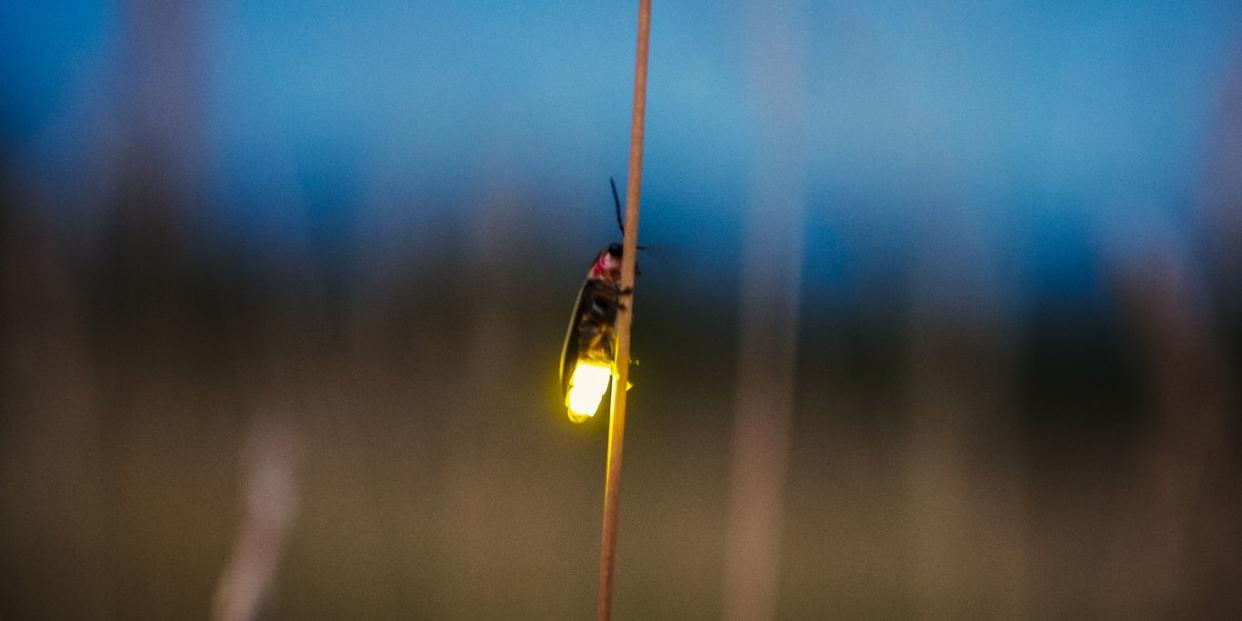Why Do Fireflies Glow? Their Magical Bioluminescence, Explained

If there’s any season that makes you feel all the nostalgia of childhood, it’s summer. Longer days and warmer nights call for plenty of evenings spent outdoors. Whether you enjoy dinner in the backyard or get a bonfire going, you preferably do so in the company of familiar glowing insects: fireflies.
Also known as lightning bugs, fireflies are part of the Lampyridae family (meaning they are actually winged beetles) and tend to make an appearance in backyards, fields, and forests every year between the end of May and the beginning of June because they thrive in grassy, humid climates. More than 2,000 species of fireflies can be found around the world, with about 170 existing in North America, per Firefly Research and Conservation (FRC), a nonprofit organization founded by firefly researcher Ben Pfeiffer.
Even though they’re known for their bioluminescence, not all firefly species have the ability to glow—but those that can utilize their light for various reasons.
What makes fireflies glow?
Lightning bugs produce a “cold light” since 100% of the energy these critters produce results in a bioluminescent glow, creating no heat whatsoever, says Ron Harrison, Ph.D., an entomologist and technical director of international franchising with Orkin. “It’s a really cool thing,” he adds.
How? Two chemicals found in their bodies, luciferin and luciferase, spur a reaction in the presence of oxygen, adenosine triphosphate (ATP, which is found in all living things), and other compounds. Luciferin is heat resistant, while luciferase (a bioluminescent enzyme) spurs the emission of light, Harrison explains. As air is directed to these compounds in the firefly’s light organ, it can actually start and stop the bioluminescence with complete control.
So, why do fireflies produce this glow?
Depending on the species, a male or female firefly can create light for a number of purposes. First, it comes in handy during mating season, according to the National Park Service. “Different species of fireflies actually have different flash patterns that are used to help in obtaining a suitable mate,” says Wyatt West, a board-certified entomologist for Ehrlich Pest Control.
Typically, the male will fly around sending light signals to a group of females seeking out the right partner, and each species has its own unique flash patterns. Once the female finds a male up to her standards—say, depending on how often he lights up and the intensity of the flash—she emits her own light and the rest is history, Harrison says. (And if they have a baby? Even the larvae and eggs emit light in certain species.)
One of the most fascinating ways to watch this process in action stems from Photinus carolinus fireflies, which synchronize their flashing patterns. Calling the Great Smoky Mountains National Park home near North Carolina and Tennessee, hundreds and even thousands of these synchronous fireflies emit between five to eight flashes of light all at once before allowing eight to 10 seconds of darkness. This light pattern can continue for hours, usually ending around midnight.

On the flipside, this form of attraction isn’t always romantic. Sometimes, certain species of female fireflies will flash to gain the attention of a male—only to eat him once he’s lured in. That’s right: Fireflies are carnivores, and they’ll feast on their own species, Harrison says. (Still, scientists still aren’t sure what their whole diet looks like.)
“There is one species of firefly where the female will actually mimic the flash pattern of a female from another species in response to the male flashes,” West says. “When the male shows up to mate, the female that mimics the flash pattern will actually eat the unsuspecting male.”
If lightning bugs sense danger, they’ll also use their glow tactics to warn predators and defend their space. “We think the blinking helps them,” Harrison says.
Do fireflies all emit the same light color?
Most fireflies create what’s described as a greenish-yellow light, although some do create more of an orange or yellow glow (this also depends on luciferase). In an interview with The World, Sarah Sander, Ph.D., an assistant professor of biology and firefly researcher at Bucknell University, said she believes fireflies glow different colors to adapt to their surroundings.
“If you’re in a particular environment, say out at dusk in the woods, there’s a lot of light around, it’s reflecting off of leaves, so it’s a very green background light,” she explained. “You might want a yellow signal that contrasts with that ambient light so that your signal will be picked up by a female and you’ll get that mating opportunity.”
Although some fireflies can emit different colors, the flash pattern is what makes them stand out from the rest, as the timing of the flash and the pattern itself “are unique to different species of firefly,” West says.
If you have fireflies around your home and you like the soft glow they create at night, keep this in mind, per Harrison: Be careful when you do lawn treatments. “They will take up residency on vegetation, sitting under leaves,” he says. “Just be sensitive when applying treatments that these animals can be there.”
You Might Also Like

